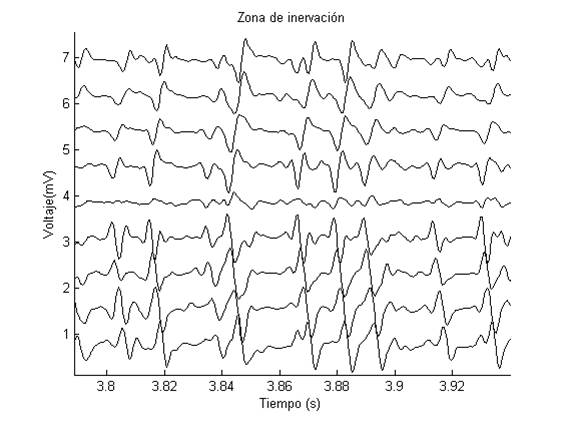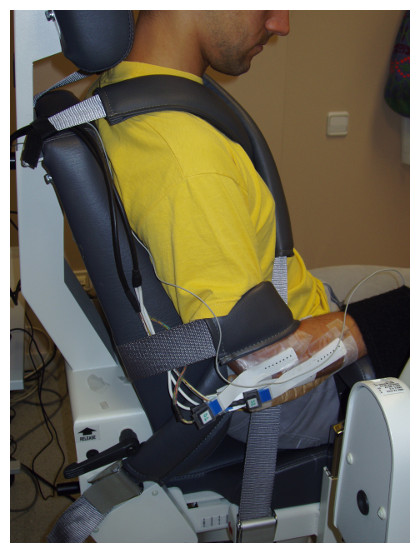Background
 A linear array of electrodes permits to record multichannel SEMG signals along a line that if it is aligned with the direction of muscle fibers of interest, can record traveling MUAPs. Non-traveling potentials will be also recorded due to “cross-talk” (download ppt
A linear array of electrodes permits to record multichannel SEMG signals along a line that if it is aligned with the direction of muscle fibers of interest, can record traveling MUAPs. Non-traveling potentials will be also recorded due to “cross-talk” (download ppt ![]() ). This technique also permits the identification of anatomical muscle properties (detection of IZ and tendons) and estimation of CV based on temporal delay between signals [Zwarts et al. 2003]. The European reference consortium in this emergent and promising technique, that it is applied in this Project, belonged to the SENIAM (Surface ElectroMyoGraphy for the Non-Invasive Assessment of Muscles) project funded by the European Commission (Biomedical Health and Research Program BIOMED II). It was composed of eight clinical and eight engineering partners [Hermens et al. 2000]. One of them is the LiSIN (Laboratory for Neuromuscular System Engineering and Motor Rehabilitation) from the Technical University of Turin (Italy) whose Director, Prof. R. Merletti, collaborates with our research group in the acquisition and analysis of these multichannel SEMG signals [Merletti et al. 2004].
). This technique also permits the identification of anatomical muscle properties (detection of IZ and tendons) and estimation of CV based on temporal delay between signals [Zwarts et al. 2003]. The European reference consortium in this emergent and promising technique, that it is applied in this Project, belonged to the SENIAM (Surface ElectroMyoGraphy for the Non-Invasive Assessment of Muscles) project funded by the European Commission (Biomedical Health and Research Program BIOMED II). It was composed of eight clinical and eight engineering partners [Hermens et al. 2000]. One of them is the LiSIN (Laboratory for Neuromuscular System Engineering and Motor Rehabilitation) from the Technical University of Turin (Italy) whose Director, Prof. R. Merletti, collaborates with our research group in the acquisition and analysis of these multichannel SEMG signals [Merletti et al. 2004].
Multichannel EMG signals obtained from electrode arrays overcomes these drawbacks and provides a much larger amount of information including (but not limited to): the (time changing) location of the IZs, the degree of muscle shortening related to joint rotation and based on the shift of the IZs, easier training (due to the larger amount of information) of neural networks or models adopted to estimate muscle features such as force or change in muscle length, central neural drive (discharge rate of individual motor units) obtained by decomposition of EMG in a train of potentials from different MUs, and anatomic information.
 To our best knowledge, our group is pioneer in the analysis of multichannel surface EMG in Spain, thanks to the long term cooperation with the LiSIN (Politecnico di Torino) directed by Prof. Merletti (by an Integrated Action in 2003-04 and publications).
To our best knowledge, our group is pioneer in the analysis of multichannel surface EMG in Spain, thanks to the long term cooperation with the LiSIN (Politecnico di Torino) directed by Prof. Merletti (by an Integrated Action in 2003-04 and publications).
Other international Groups working on multichannel EMG signals are the Neuro Muscular Research Center at Boston University, the Palo Alto Rehabilitation Research and Development Centre (Stanford University), the Neurophysiology of Movement Laboratory from the University of Colorado and many other groups in Europe, partners of the SENIAM project.
There are also different national groups working on EMG analysis for different purposes as for example Fatronik-Tecnalia, currently working in solutions for people with reduced mobility of the lower extremities, the Brain-Computer Interfaces research group from the University of Zaragoza working in EMG interfaces for machine control, the Dept. of Electrical and Electronic Engineering from the Public University of Navarra, or the Bioengineering Group from the CSIC directed by Ramon Ceres, currently leading the European Project TREMOR (main researcher: José Luis Pons).
Share: